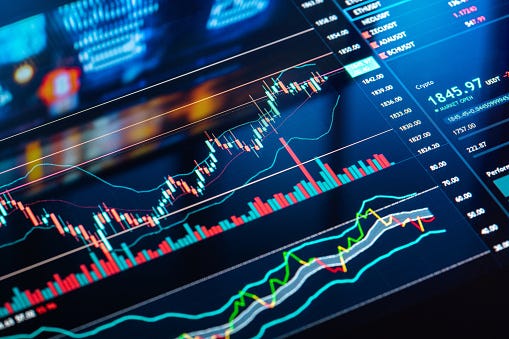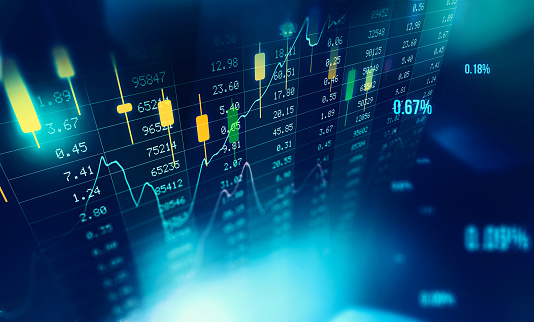What’s certain is uncertainty.
Part of investing requires becoming comfortable with the uncomfortable. ALWAYS. You cannot build true wealth without stepping out of your comfort zone.
“Risk whatever you’re willing to loose” is a classic slogan to remember.
Without it, there’s no exchange.
You must get used to it and the best way to do so is by adopting a buy and hold strategy. Long-term passive investing historically beats out active investing for this reason. At no matter what age, over 50% of your portfolio should be passively invested through diversified broader index funds and ETFs. It’s a slow but fool-proof way.
Yet, for those with a short temperament, extra play money or lack of patience or time, they choose to still day trade and bet on single holdings such as meme stocks or digital assets instead. Luck is the only thing holding them up.
Day traders loose roughly 80%+ of the time they trade and over 35% of their capital. This all adds up overtime. There’s no sugarcoating results. It doesn’t work out
Why does this happen so frequently to day traders, technical analysts, and stock pickers?
What we believe is a great deal or has potential most likely had already gone through its glory days or was inflated in the first place. It’s impossible to predict what will happen next since there are so many variables within a company.
The CEO could spark retirement rumors, an allegation could come about overnight, the company could engage in a stock buy back/share repurchasing or stock split, merge or get acquired, and or change their name that could all fluctuate the price. All of these factors could crush or lift the stock price which means relying on your expertise and charting skills aren’t the best outlet.
We are never smarter than the market.

Why Forecasting Is Necessary
In the 1980s we predicted by now there would be flying cars and we would be living like the Jetsons. Unfortunately, we haven’t gotten this far but we have gotten into speculative investments, cryptocurrency, Big Tech, become a more divided nation, heated planet, and witnessed a global pandemic that the wealthiest countries, most notably the U.S. couldn’t even control.
Who would have thought that?
Thankfully it’s not all bad news. The stock market has reversed course since its slump in March 2020 and reached all time highs within a few months. This means there is a low earnings yield for companies as well. It has never been seen within this many companies since pre the Dotcom bubble. A low earnings yield indicates corporate profits do not keep up with stock prices and inflation. Valuations are through the roof and nothing is a bargain anymore.
Excess liquidity in the market was mainly caused by massive stimulus on the fiscal and monetary side. Consumers were flushed with cash, created financial buffers, bulged up their investment portfolios, and became interested in sprucing up their financial literacy. Savings rates went up to a record 30% now unfortunately back down to 9% to November 2019 levels, unemployment is at 4.2%, and the economy witnessed its fastest recovery all within a few months.
At the start of the pandemic, covid shut down the economy and it went into free-fall. Manufacturers and producers halted production, laid off workers, lowered wages expecting consumers not to spend as much as they did during a brief recession but in fact demand went the other way. Not into events and travel this time but instead for furniture, real estate, home media, tech, and STOCKS. LOTS OF STOCKS or as Musk calls them, STONKS. This pent-up accelerated unexpected demand caused a shortage of shipping containers along with supply chain constraints which lead to inflation. Mixed with new variants, shutdowns, and political discrepancy, turmoil and uncertainty have plagued the markets and worried forecasters on their already off predictions.
Difficulty in the Ditch
Predicting anything is different. I’m not going to say how unpredictable the pandemic was. Although a pandemic occurs every century, no one would have expected a shutdown to happen in our lifetime or that a disease could spread so rapidly in the 21st century. We assumed that’s history and our latest technology and billion dollar pharmaceutical companies know what they are doing. Thankfully, they rapidly raced for a cure even as new variants emerged. We may have to live with this virus forever as an endemic.
It was unprecedented for sure. The first and hopefully last pandemic we will witness. Covid may have come by surprise but what was expected was a recession which occurs every 8–10 years. Yet the raging bull market persisted 13 plus years later and erased all losses, including from Black Friday now up 2%, ~25% for the year.

Are Forecasts Worth It?
Forecasts are an essential part of analysts’ roles and require a lot of analysis, contemplating, comparing, and perspectives but sometimes these robust intricate forecasts aren’t worth it especially after an accidental two years.
Usually Wall Street’s forecasts, not Silicon Valley’s tend to right by accident similarly to not studying for a test and acing it. Just as it’s almost impossible to consistently beat the market, forecasting the economy and market with accuracy and consistency is insanely difficult. There are just too much variables, too many Tweets, and too many investors looking all around!
According to the WSJ, “the median Wall Street forecast from 2000 through 2020 missed its target by an average 12.9 percentage points — which was more than double the actual average annual performance of the stock market.”
This is actually decent according to estimates. Although this may seem off the record, its better to be safe than sorry right? A year ago the forecast for the year end close for the S&P 500 in 2021 was 3,800 accounting to a Bloomberg survey, not Bloomberg itself. They have too many terminals and algorithms that can propose a better estimate.
With the Santa Clause Rally approaching, investors tend to be the most bullish eager to tie a bow on the closing year. But lets not get too complacent as next year is projected to be a difficult, unpredictable, and shall I say, flat year according to several reports.
With inflationary fears, supply-chain constraints, savings dwelling for low-income earners, unemployment and job openings slowing, has the recovery recovered? Will wages keep up with inflation? Will the housing bubble burst? How can we explain Tesla is worth more than more than half of the S&P500? Is the Dotcom bubble upon us? Will a college degree become priceless? Is the Fed’s tapering rushed?
Too many unknowns not enough certainties.
Welcome to the investment world.
Make all the predictions you want but only time will really tell. With the stock market oscillating between record highs and bearish sentiments, all we can do is invest for the long-term and stay hopeful. Don’t get caught up in daily price swings and the Reddit feeds without looking long-term to keep your ego, sanity, and time in check. Volatility is a given in the short-term.
It’s important to remember that sometimes too much information is too much. As a student, I often become a victim of information overload and start forgetting everything the more I try to cram into my brain.
Ignorance is bliss a lot of the time. There’s nothing wrong with asking a monkey to throw darts to predict the market’s outcome. Their track record isn’t too shabby.
But what’s not the way to go is being a grinch around the holiday season and negative about next year’s performance. Overtime, the broader indexes go up, not daily. Stick to trades you know will serve you and that you use as a consumer! That is a basic yet logical way to identify winning brands.
And last thing. You aren’t smarter than the market. Believe this and your predictions will turn out better.
Merry forecasting!

